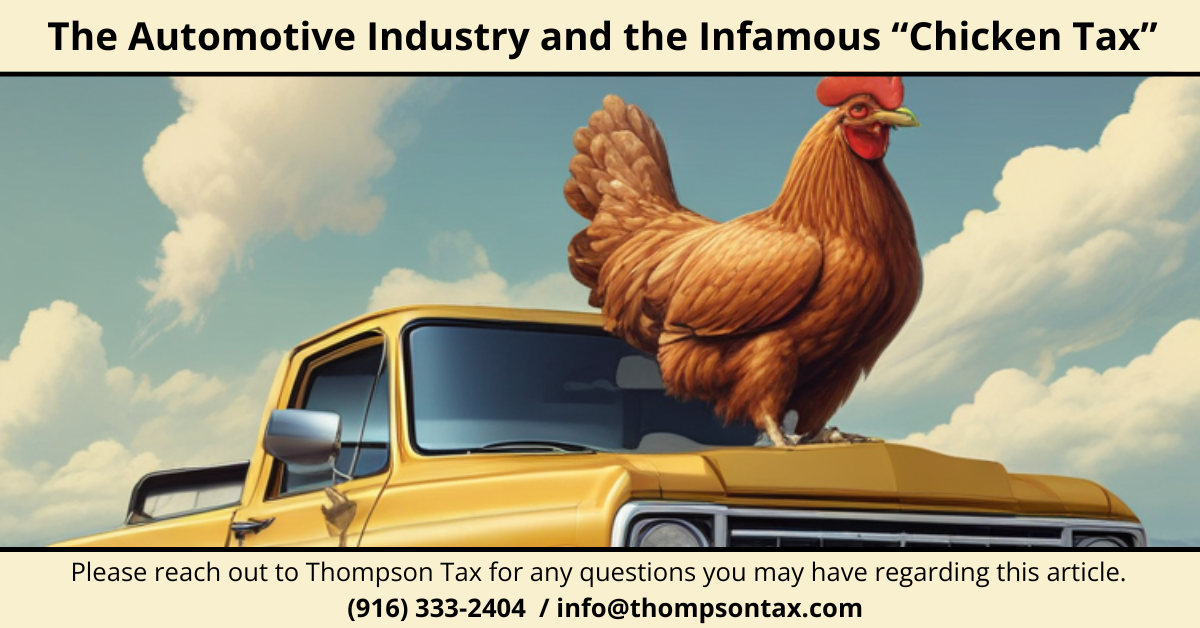
In the complex world of international trade and taxation, few policies have had the lasting impact of the “Chicken Tax.” The tax, proclaimed in 1963, was imposed in 1964 as a retaliatory measure during a trade dispute over poultry. This obscure U.S. tariff continues to influence automotive trade policy and supply chain strategies to this day. For companies managing cross-border operations, sales and use tax exposure, and import compliance, the Chicken Tax provides a powerful case study in the long-term consequences of tariff regulations.
A Trade War Hatched Over Poultry
U.S. poultry exports flooded European markets during the late 1950s and early 1960s, especially in West Germany and France. American producers, backed by industrial-scale farming and government support, offered chicken at prices local European farmers couldn’t match. In response, the European Economic Community (EEC)—a precursor to today’s European Union—implemented tariffs on U.S. chicken imports.
In retaliation, President Lyndon B. Johnson responded with a series of targeted tariffs on European goods, including brandy, dextrin, and potato starch. Most notably, he imposed a 25% tariff on imported light trucks—a move aimed squarely at German automakers like Volkswagen, whose vans and pickups were gaining popularity in the U.S. market.
This 25% tariff, which came to be known as the “Chicken Tax,” far outlasted its original purpose and has remained in effect for over 60 years.
The Lasting Effects on Trade and Tax Policy
For businesses engaged in international trade, the Chicken Tax highlights how tariffs—like sales and use taxes—can dramatically alter business models, supply chains, and market dynamics. Its continued enforcement has had several notable impacts:
- Protection for Domestic Manufacturers
The Chicken Tax insulated U.S. truck makers from global competition. Domestic giants like Ford, GM, and Chrysler retained dominance in the light truck and pickup segment, reaping the rewards of limited foreign competition. This is an example of how indirect tax policy can create structural advantages for certain industries.
- Creative Compliance and Tariff Planning
Global automakers seeking access to the lucrative U.S. truck market have employed creative tariff avoidance strategies to reduce their tax exposure. These methods often involve reclassifying vehicle types or modifying vehicles post-importation to qualify for lower tariff rates. This practice, known as tariff engineering, saved millions until U.S. Customs eventually closed the loophole. These practices reflect the critical need for effective trade compliance and indirect tax consulting strategies in international business.
- Manufacturing Localization
Rather than incur the 25% duty, many foreign automakers opted to build production facilities within the U.S. This not only avoided the tariff but also contributed to job creation and local economic growth. For tax professionals, this underscores the importance of state and local tax planning, especially when evaluating tax incentives for in-state manufacturing or distribution centers.
- Limited Consumer Choice and Higher Costs
By restricting foreign competition, the Chicken Tax arguably reduced innovation and price competition in the U.S. light truck market. With fewer international players, prices remained high, and consumer options were limited. For businesses importing goods, this highlights how trade tariffs and use taxes can shape consumer markets just as significantly as corporate tax rates.
Why This Matters for Tax Advisors and Global Businesses
Although the poultry dispute that triggered the Chicken Tax ended decades ago, the tariff remains—largely due to political inertia and the strength of domestic lobbying. For companies engaged in import/export operations, understanding long-term trade policy is essential for risk management and tax compliance.
At its core, the Chicken Tax is a textbook example of how tariff policy intersects with indirect taxation, customs planning, and business strategy. Just as businesses must manage their sales and use tax obligations at the state level, they must also consider how federal tariffs can impact pricing, sourcing, and profitability.
Whether your company is importing machinery, distributing consumer goods, or navigating multi-state tax regulations, it’s critical to evaluate the broader tax landscape—beyond income taxes alone.
The Chicken Tax: A Cautionary Tale for Modern Trade
Today, the global supply chain is more interconnected than ever. Yet the Chicken Tax remains a barrier—proof that once a tariff is in place, it can be difficult to undo, even if its original purpose becomes obsolete. In many ways, it is a cautionary tale for companies that fail to anticipate the ripple effects of changing tax and trade policies.
Navigating the Complex World of Sales, Use, and Tariff Taxes?
At Thompson Tax, we specialize in sales and use tax consulting and indirect tax strategy. Our experienced professionals help businesses reduce risk, maximize efficiency, and stay ahead of evolving regulations. Whether you’re expanding into new markets, restructuring your supply chain, or facing a sales tax audit, we are Your Trusted Tax Advisors.
Contact us today to see how our tailored solutions can support your business goals.